by Venchito Tampon Jr | Last Updated on July 5, 2023
Learning how to get blog post ideas is a skill that can be learned easily and improved through research, reading content marketing blogs, and investing in data-capturing activities like surveys and polls.
Blogging requires inspiration to consistently publish high-quality content that your target audience wants to read and share with their colleagues and helps your site earn links from relevant blogs/sites.
In this post, I’d like to share 100 ways to find topics for your next blog post, with step-by-step instructions and real-life examples to help you apply every technique in the list.
But before that, here are a few things you should consider to maximize every blog topic-generation technique in this post:
- Don’t just focus on identifying the target keyword of the post/page; try to understand what topic is being discussed to create a comprehensive post about that topic.
- Determine which content format attracts the most number of readers/visitors. Every industry has its preferred content format (e.g., family travel blogs prefer photo-based content with minimal text).
- Identify synonyms, entities, and technical terms from successful blog posts or pages and include them in your content to improve your page’s topical relevance and search ranking potential.
Let’s head over to actionable ways to find blog post ideas.
21 Ways To Get Blog Post Ideas
1. Other website’s successful pages
One of the easiest blog topic generators today is to get inspiration from other brands’ successful posts or pages.
Because those pages had successfully brought traffic to a certain brand and got traction on other blogs (guest posts, links, and social engagement), you can rest assured that they have high potential to send organic, social, and referral traffic to your blog as well (especially if the post provides unique information about that specific topic).
How to do it?
Step 1: Plugin in other websites’ homepage URLs (could be a competitor or an authoritative niche blog) to Ahrefs’ Site Explorer.
Step 2: Go to Top Pages.
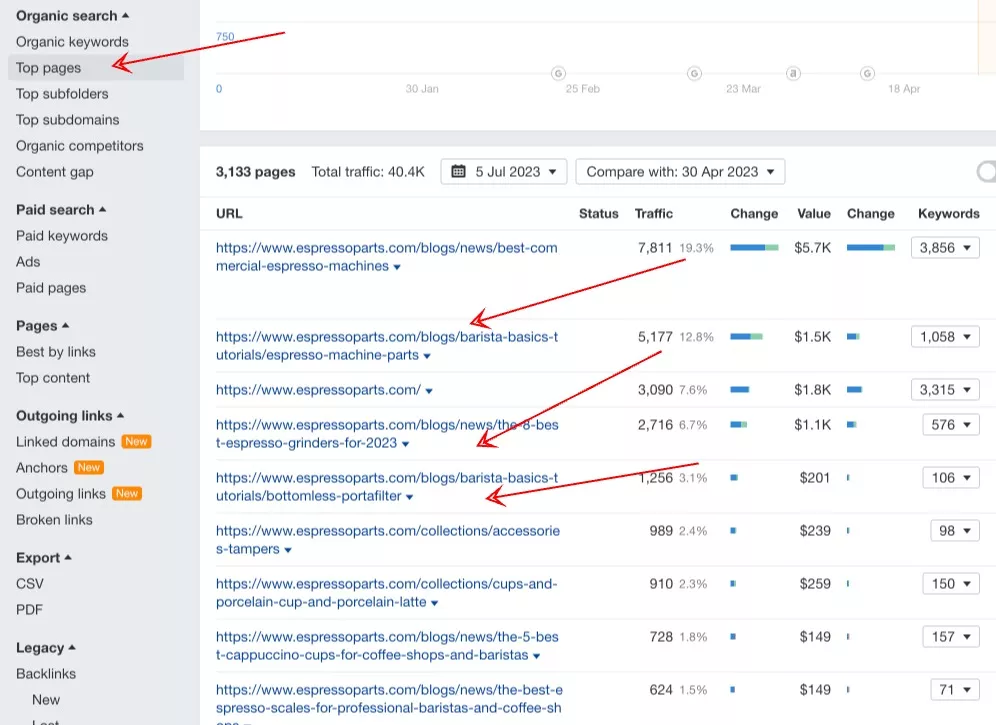
Step 3: Check for relevant keywords aligned with your content theme.
Given that pages on Ahrefs are ranked from highest to lowest traffic, you know that the topics covered by the top pages have a high potential to generate organic traffic to your website.
2. Use a micro-survey tool
In offline marketing, surveys collect data from customers or audiences prospected by the brand to make better product decisions and create better strategies to promote their content.
This same marketing approach applies to online marketing. Online brands can take advantage of surveys to easily determine their audience’s wants and need to create content assets that are highly valuable to the community.
One of the recently released micro-survey products is Qeryz. It is a tool that can help you gather data by asking questions to your visitors. The survey form can be visible on any page of your website.
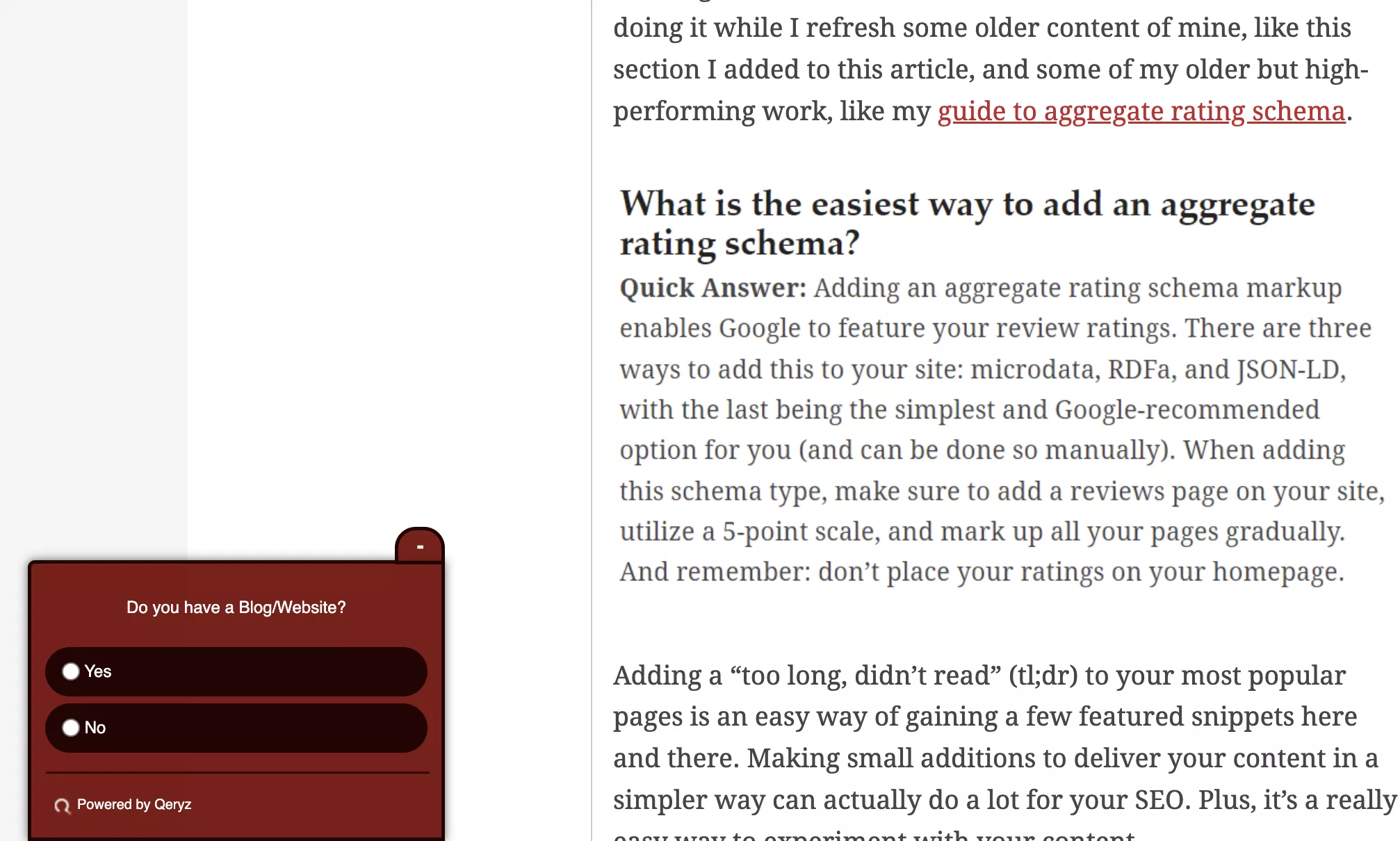
How to use Qeryz?
Step 1: Install Qeryz plugin to your WordPress blog.
Step 2: Add questions to Qeryz platform.
Pro tip: You can also link to your important landing page after asking a few questions.
Step 3: Brainstorm blog topics based on the data you’ve gathered from your survey form.
3. Determine emerging topic trends in your niche
An authoritative blog proves its expertise when it covers industry news and updates or at least provides actionable tips in its blog posts that are related to the latest industry trends.
How do you identify niche trends?
Step 1: Go to Exploding Topics.
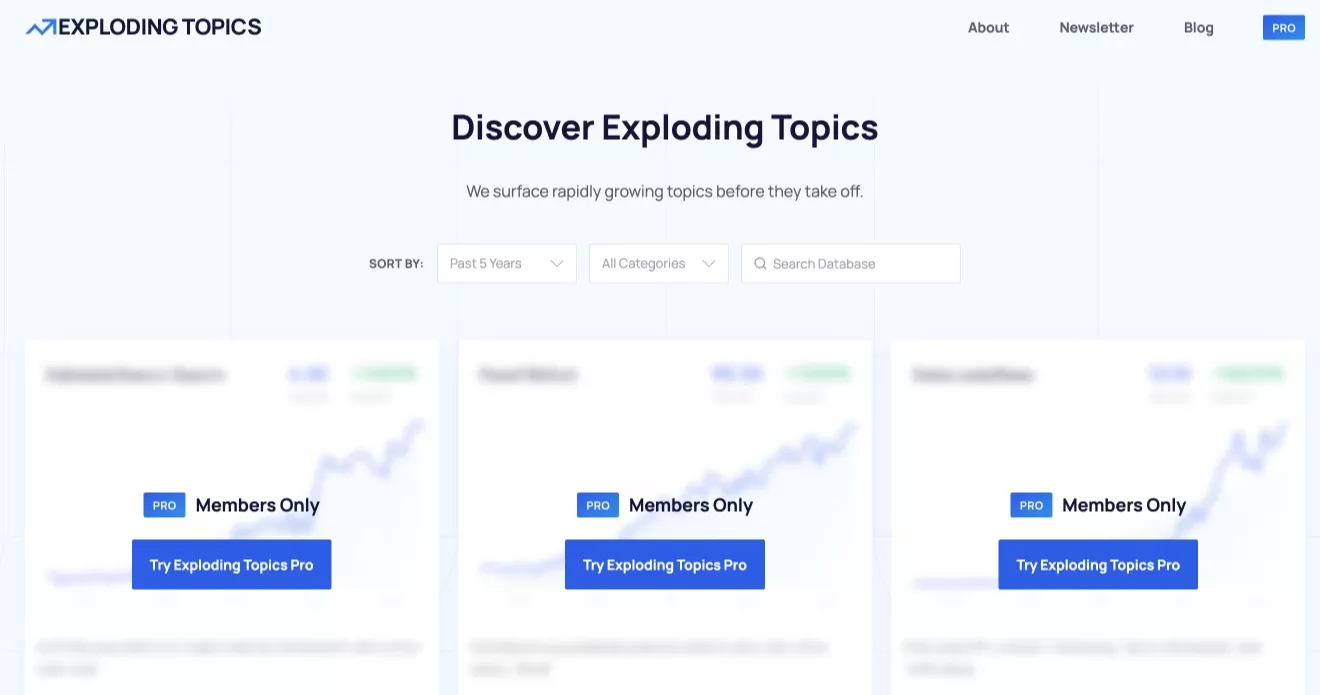
Step 2: Subscribe and watch for the latest topics in your industry.
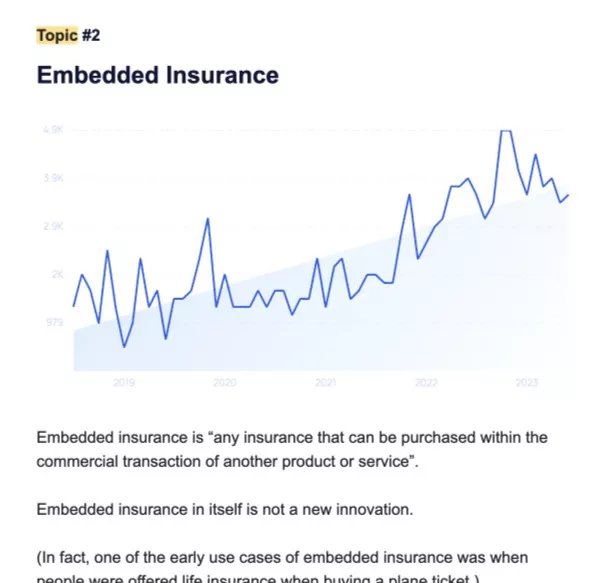
Step 3: Be the first to create content around those emerging topics you can use once it hits.
Think of how you can create the best content around those queries.
4. Get insights from Reddit Ask Me Anything (AMAs)
Reddit is one of the user-generated websites where you can find community-ranked content that is well-received by its members.
One of my favorite topic generation sections on Reddit is Reddit AMAs. The interviews for each industry expert can provide you with many ideas and questions people want answers to, which are good topics to consider for your blog.
How get ideas from Reddit AMA?
Step 1: Go to Reddit and search for [head term] AMA (e.g. parenting AMA).
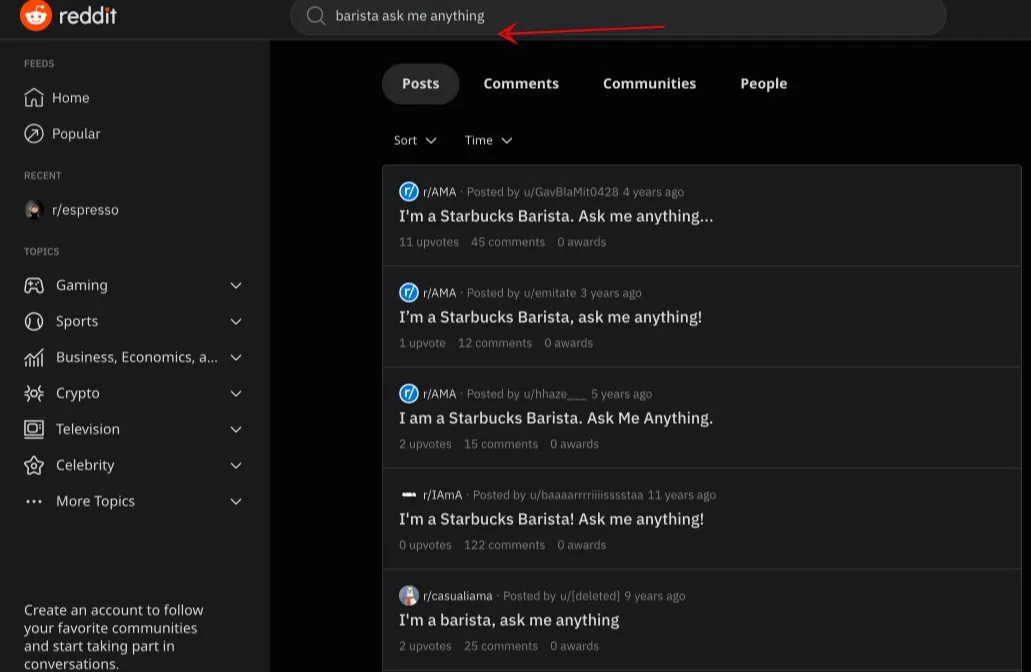
Step 2: Select a Reddit AMA in the search results that gained several comments in the discussion.
Step 3: Skim all the questions in the discussion and list those relevant to your brand that you know you can answer thoroughly in your post.

A few more tips for creating content using this blog ideation technique:
- Target at least two questions in your post and answer them with the most comprehensive details/information.
- In your posts, provide useful data (case study) to answer those selected questions.
- Make your answers straightforward and clear to your readers.
5. Data-based infographic
Most infographics fail because they do not provide real value to their audience.
Infographics are meant to share data with readers to apply the information and message in the infographic to their daily activities.
How to find ideas for your infographic?
Step 1: Go to Reddit.com/dataisbeautiful
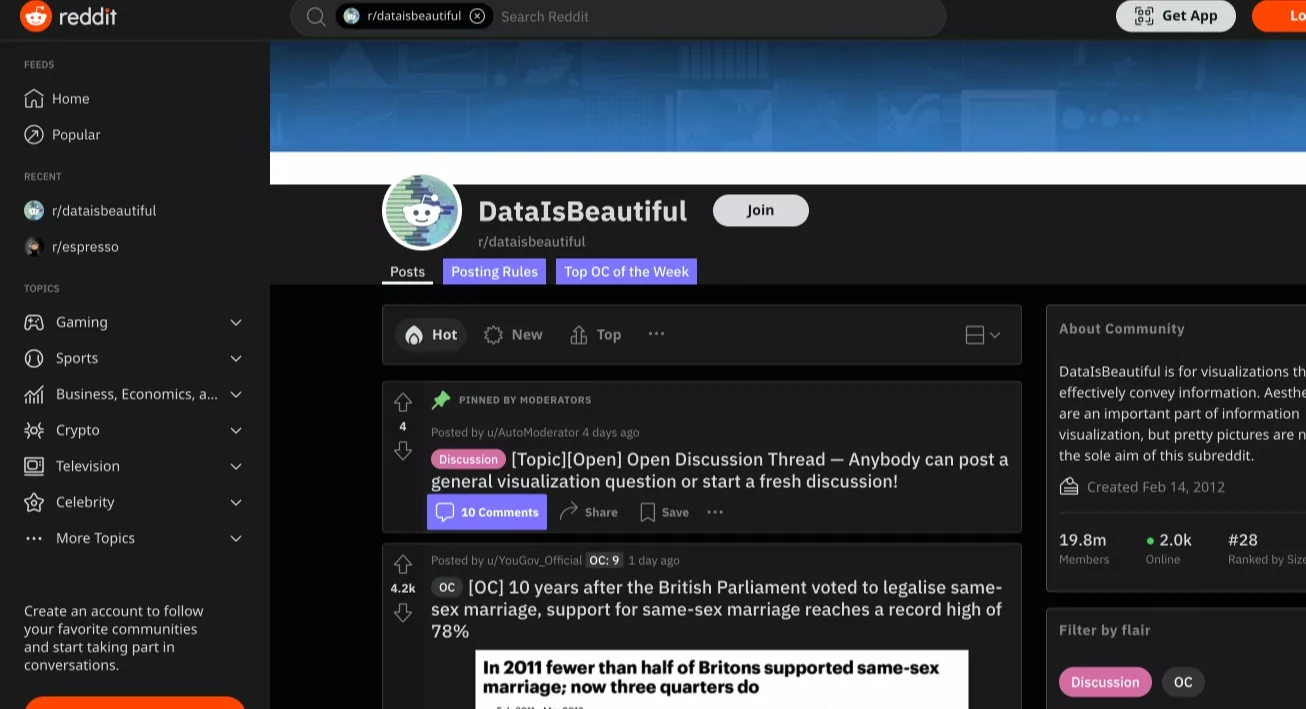
Step 2: Check the first 10 infographics in the Reddit search results.
Step 3: See how to use the same formats or concepts in your brand’s content marketing.
You don’t need to replicate the same image but get inspiration from those infographics.
6. Famous quotes
Quotes provide bit sizes of learning for everyone.
Because you can learn one good message or tip from a quote you want to share with your friends or colleagues.
Famous quotes can be one of your topic ideas for your blog.
Look at this page on Okdork that lists all famous business and internet marketing quotes.

How to find famous quotes?
Step 1: Go to BrainyQuotes and click on the topic(s) of your choice.
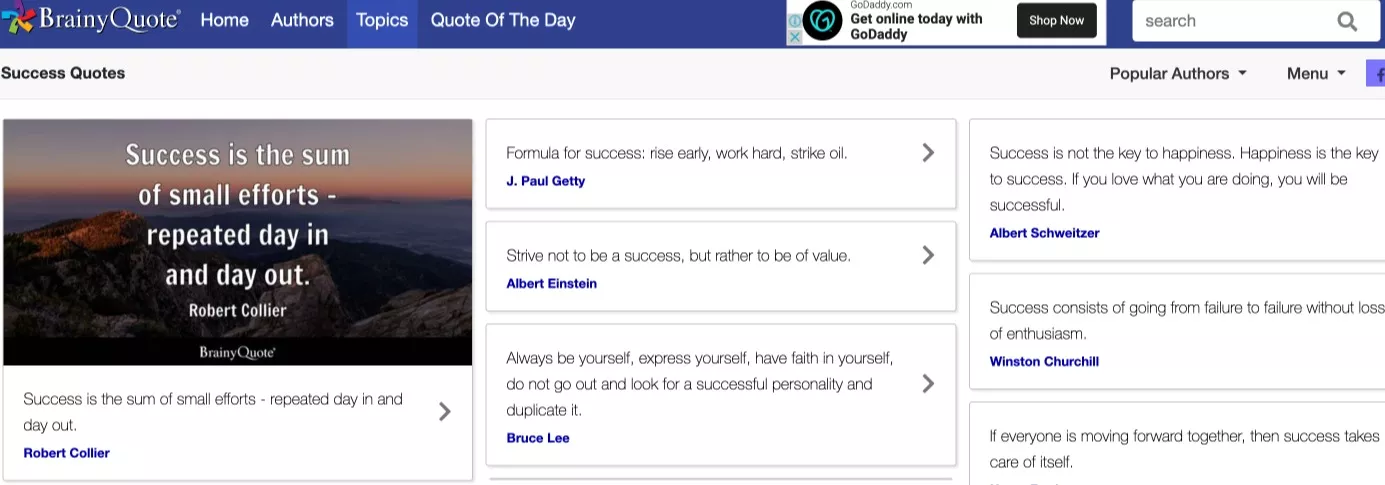
Step 2: Choose quotes related to your industry and categorize them under sub-topics (e.g. parenting for general family quotes).
Step 3: Publish it on your blog.
7. Case studies
Case studies emphasize your experience as a service provider or product creator simply by allowing people to know how you improved your services for your client, your content, your website, or your business using a tool, service, or strategy.
Why do case studies work?
- They show the brand’s expertise about certain topics people in the industry would care about.
- Stories make it more compelling for others to share the page or even link to it from their relevant blogs or sites.
- When turned into a visual (e.g. infographics), the content is much more likely to be picked up by media outlets (journalists) and will create stories around it, especially if the data gathered is unique and interesting to their audience.
Here are a few examples of case studies that you can check out for references:
8. Interrelated topics using Answer the Public
Understanding the depth and width of the topic you want to cover on your blog can help you create the perfect content theme for your website.
How to do it?
Step 1: Go to Answer the Public and search for your head term.
Step 2: Generate topically related questions.

Step 3: Discuss those ideas in your blog content or create a spreadsheet of terms/keywords that you might want to include in your posts to increase their relevancy factor.
9. Influencer’s top words in social
If you are new to blogging, one of the best ways to get inspiration for your blog is to stalk your influencers’ social profiles. By identifying the most used words/phrases in their tweets, you can determine what topics they’d like to share religiously on social platforms, particularly on Twitter.
How to do it?
Step 1: Go to Sparktoro, Sign in, and type in your head term on the search bar.
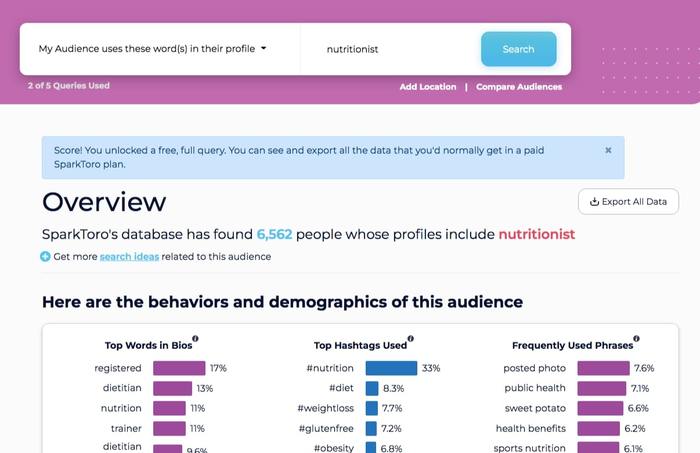
Step 2: Find interesting words/phrases, hashtags, and frequently used phrases based on your head term.
10. Success and failures
Transparency is one of the key factors to success in niche blogging. The more transparent you are to your audience, the more likely they will trust you and your work (content).
A few things to keep in mind when sharing successes and failures on your blog:
- Add disclaimers to your content if necessary, such as saying that you’re not an affiliate marketer or promoter of a certain product or service – if, in case, you will include any in your post.
- Provide actual data to your content – never add or remove things/elements to add colors to your page.
- Content with more words in length (thousands) gets more attention than simply publishing a 500-word article.
Let’s take a look at this success post by Matthew Woodward.
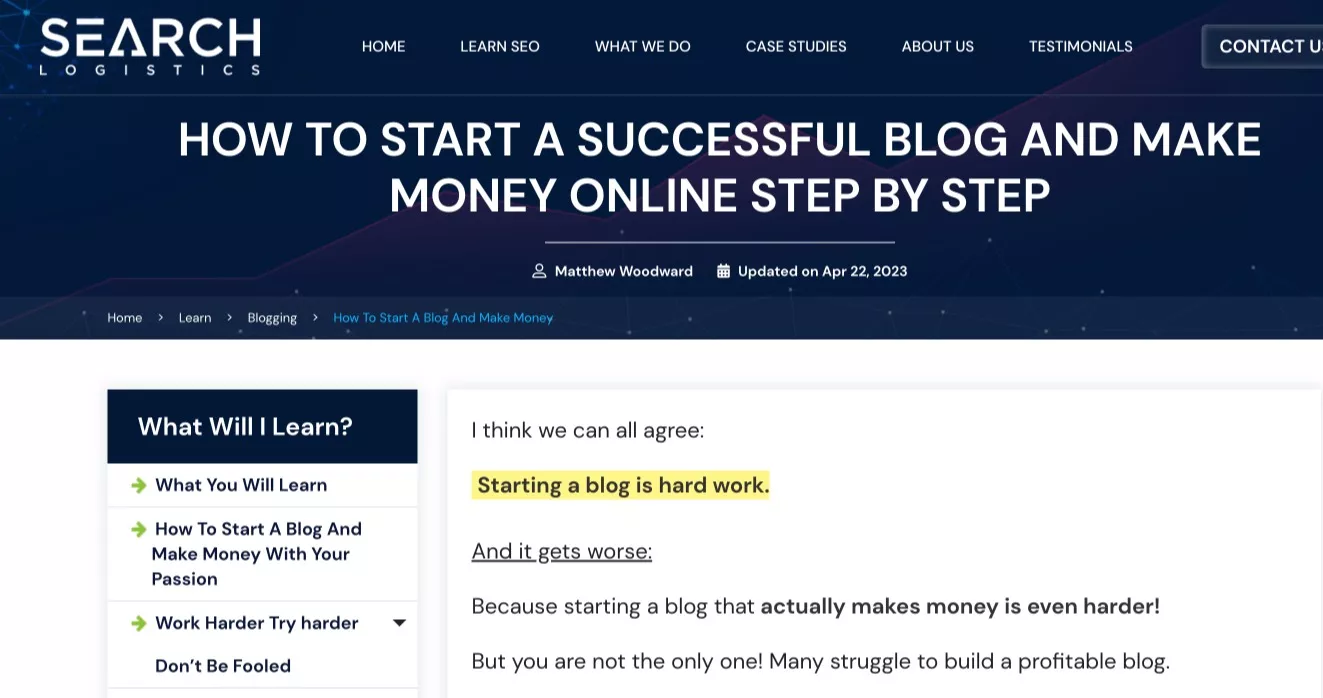
The post earned much attention from the internet marketing community (encouraging more people to start their own blogs from scratch).
Things that make Matthew’s post work:
- Emphasize learnings instead of just bragging about his strategies that worked effectively for his blog (the first section, What You Will Learn, adds value to the readers).
- The post ended by asking for feedback or sharing with his readers, which put more eyeballs to the content when people started to share it with their followers.
- Provide more ways for new visitors to see his content by making the post sticky on the top side of the website.
The focus of the success post is on your blog, website, or brand alone, not on specific products or services you are offering. Otherwise, they are considered case studies already.
There is no step-by-step guide on how to do this because this is on a case-to-case basis – if you succeed, you can write about your success on your blog.
11. Twitter hashtags
Twitter is the best source of trending ideas in the community, whichever industry you are in.
Because people usually engage with other folks on Twitter, you can find a lot of questions, comments, or updates that will inspire you to write your next blog post.
How to do it?
Step 1: Go to Twitter and search for #headterm (e.g. #parenting)
Step 2: Skim for interesting ideas, links, articles, questions, or comments about that specific head term.
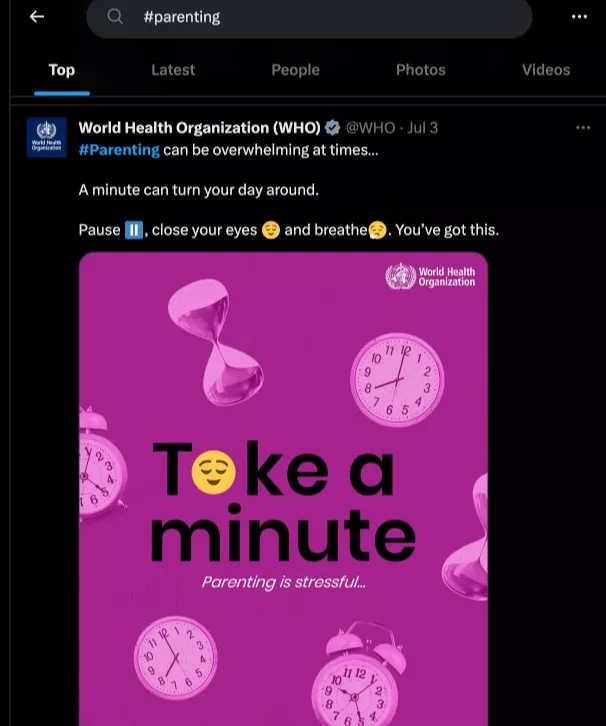
Step 3: Check out related hashtags and prospects for more status updates on Twitter.
12. Common mistakes in your niche
In any industry, there are mistakes to commit. For parenting, not spending too much time with kids is a huge mistake for them already. For SEOs, blocking your important pages in your site’s robots.txt file is a mistake to be considered by many folks.
The point here is to use mistakes as a topic for your blog.
How to do it?
Step 1: Google search for [niche] mistakes (e.g., SaaS).
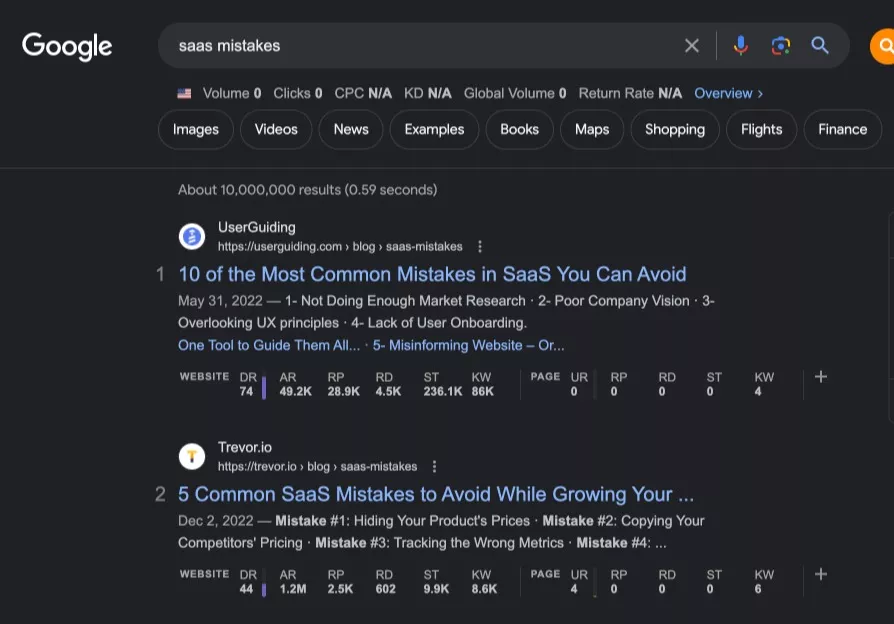
Step 2: Visit each page in the search results and skim what specifics you can discuss in your post. For my above example, SaaS mistakes can be classified into SaaS pricing and metrics. You can focus on one type or discuss both topics in this case.
Step 3: Gather all the points (mistakes) you’ve found in your research (Google search).
You can also ask questions of niche bloggers to get more information for your blog post.
13. Amazon Book Search
Amazon is one the most popular bookstores today, bringing millions of visitors to their website every month.
Digging into online bookstores is one of the untapped content ideation techniques. Topics discussed in books and subcategories in bookstores are inspirations you can use for your blog content.
How to do it?
Step 1: Go to Amazon Book Search. Search for your target head or secondary term/keyword.
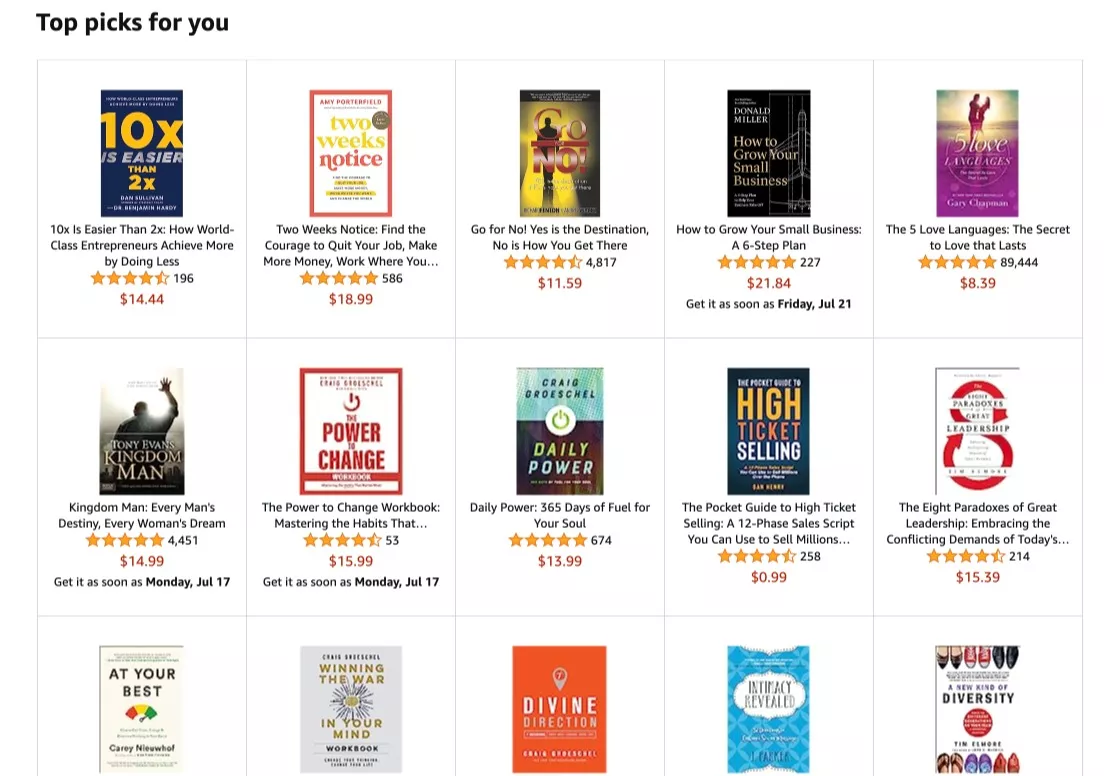
Step 2: List down ideas from the news & notable section. You can also check out book titles that are unique and interesting to your audience.
Step 3: Populate your list by adding ideas from the subtopics section of the Book (left side of the page).
14. Collect content contributions from top personalities
Collecting content contributions (insights) from influencers or experts in your industry is one of the best ways to generate a blog post these days, given that collaborative content can create a detailed explanation of the topic chosen to be discussed by the blogger.
Tips from subject matter experts can bring out untapped knowledge to the community, making the content unique and outstanding to its audience.
Below are some good examples of crowdsourced content from two industries.

Actionable tips for collecting content contributions from experts:
- Choose a specific topic and bloggers you think could provide valuable insights to your question (the more interested they’re, the higher the probability of earning highly valued tips).
- After collecting tips from experts, invest in making the collaborative post attractive to readers (add some visual designs if necessary to entice visitors to share or link to it from their blogs).
- If possible, provide incentives to contributors to encourage more participation from them in the future.
15. Advanced Twitter Search
Searching for trending or hot social topics is easy with Twitter Advanced Search.
How?
Step 1: Do a Twitter search for your head term or keyword. Then click on Advanced Search on the left side of the Twitter screen
Step 2: Use available features in Twitter Advanced Search to look for specific tweets, questions, or comments about a topic or keyword.

A few tips to maximize the use of Twitter Advanced Search:
- Enable the location feature to find localized tweets or topics.
- For international searches, choosing the specific language you only want to see in the search results is better than the default option (any language).
- Check the Question option to find only question tweets in your Twitter search.
16. Emphasizing benefits and features in products
Product reviews have been the common type of post for many affiliate marketers in almost every niche today. Aside from the monetary benefit it can provide bloggers, product review is a great way to demonstrate their authority about a certain topic by adding benefits or value to their readers (showing how the product can improve their lives).

Things to make your product review earn the desired attention from the community:
- Use your own screenshots and not just grab existing screenshots of used products.
- Add disclaimer sentences to your post to make your audience aware that links pointing to product sites are affiliate links.
- Don’t add many external affiliate links (at least two within the body of the content is enough to be noticed by your readers).
- Categorize your product reviews and use subcategories in URLs like this example below.
17. Favorite blogs/bloggers
Curation removes the mental blocks of writers because doing it only requires them to organize things under the same category in one big post.
Examples of curated content are:
- Social influencers in the industry (e.g. Top 10 Parenting Bloggers You Should Start Following)
- List of recommended products
- List of companies sorted by highest to lowest revenues
- Favorite blogs or bloggers you should start reading or following now
Now, let’s focus on the last example.
How to curate your favorite industry blogs or bloggers?
Step 1: Do a Google search for niche blogs (do it in case you still don’t have any list of popular blogs in your industry). But if you already have a list, grab your notes and start researching more about your favorite bloggers.
Step 2: Think of how you will organize your list of blogs/bloggers. You can try any of the following:
- Organize according to the highest to lowest traffic potential (use Ahrefs).
- Organize according to their engagement levels (use # of comments per post and social shares as your basis).
- Organize according to their number of social followers (e.g. Twitter followers).
Step 3: Choose whether you want to make your curation weekly, yearly, or in no time (evergreen). For yearly curation, your only disadvantage is that you need to publish curated post year after year, while for Evergreen, you’ll need to update the post (add new popular blogs or remove non-existing sites from the list).
18. Keyword Tool
Keywordtool.io is one of the effective keyword research tools that can provide instant long-tail keywords and topical terms you can target for your blog content.
How to do it?
Step 1: Search for your head term in Keywordtool.io.
In the drop-down menus, you can choose your International Google search and language for non-English blogs.
You can copy all the terms in search results by clicking the Copy All button, then paste those terms to your document (e.g. spreadsheet).
Step 2: Populate your list using secondary term keyword research.
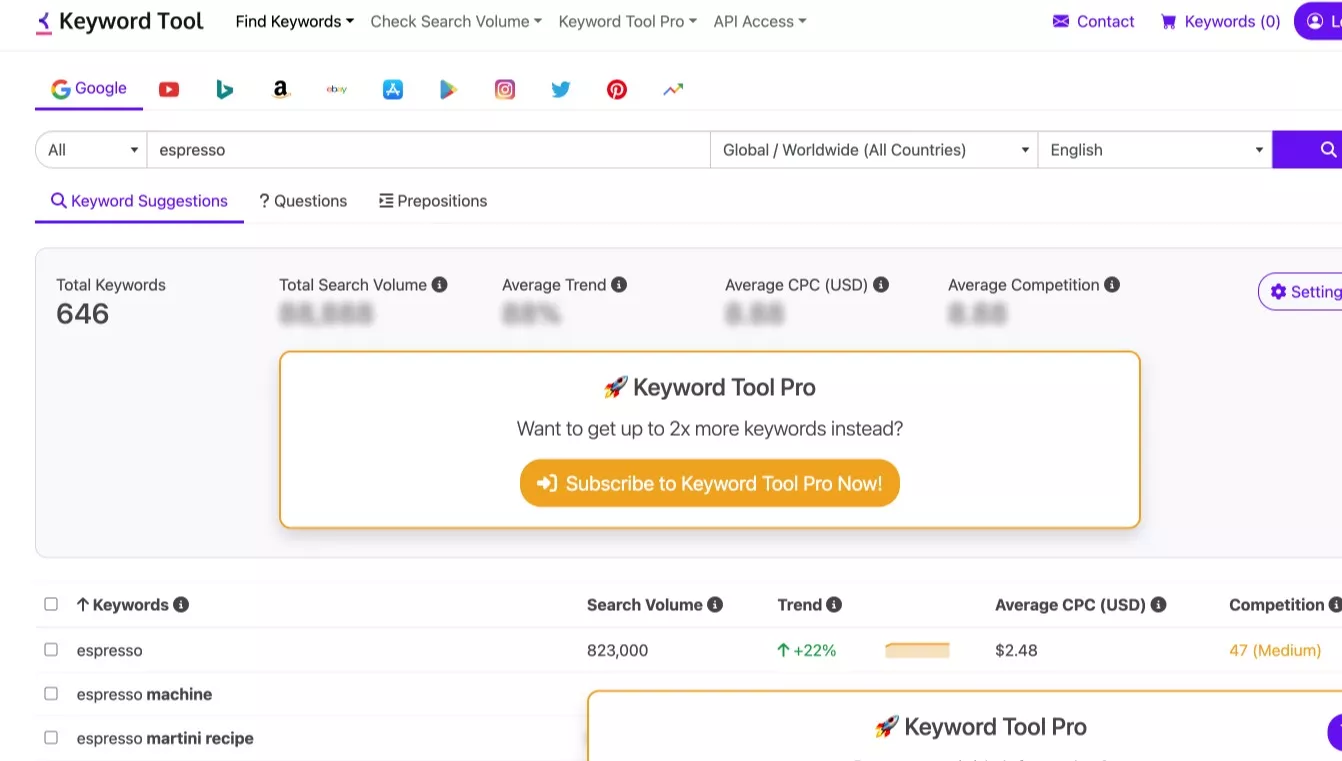
Step 3: Identify two or more related terms about the same topic and target them all in your high-quality content (don’t keyword stuff, optimize for the topic you want to rank for).
19. Comprehensive resource/guide
Striving for better marketing lies in improving the brand’s content marketing campaign. This includes producing only high-quality content on the site that can resonate with the community targeted by the brand and improving older pages that can potentially rank in search results and bring more new targeted visitors.
In Backlinko’s skyscraper strategy, Brian Dean shared three basic steps to increase search traffic through content creation:
- Find link-worthy content
- Make something even better
- Reach out to the right people.
This process is very simple but will require a huge time and effort to master this content approach.
I will talk about the second step – make something even better.
One way to surpass the quality of someone else’s content is to understand what is lacking within its context, its design and structure, and most importantly, the information that a reader in your community should obtain from the post.
Here’s how to do it.
Step 1: Do a Google search for a target keyword (you can grab one term from your keyword list gathered from the methods I’ve shared with you earlier).
Step 2: Identify what’s lacking in the pages listed in search results. It could be the design, structure, and information the page provides. List all these important notes in one document to remind you as you create your content.

Step 3: Make your content the most comprehensive resource targeting your keyword.
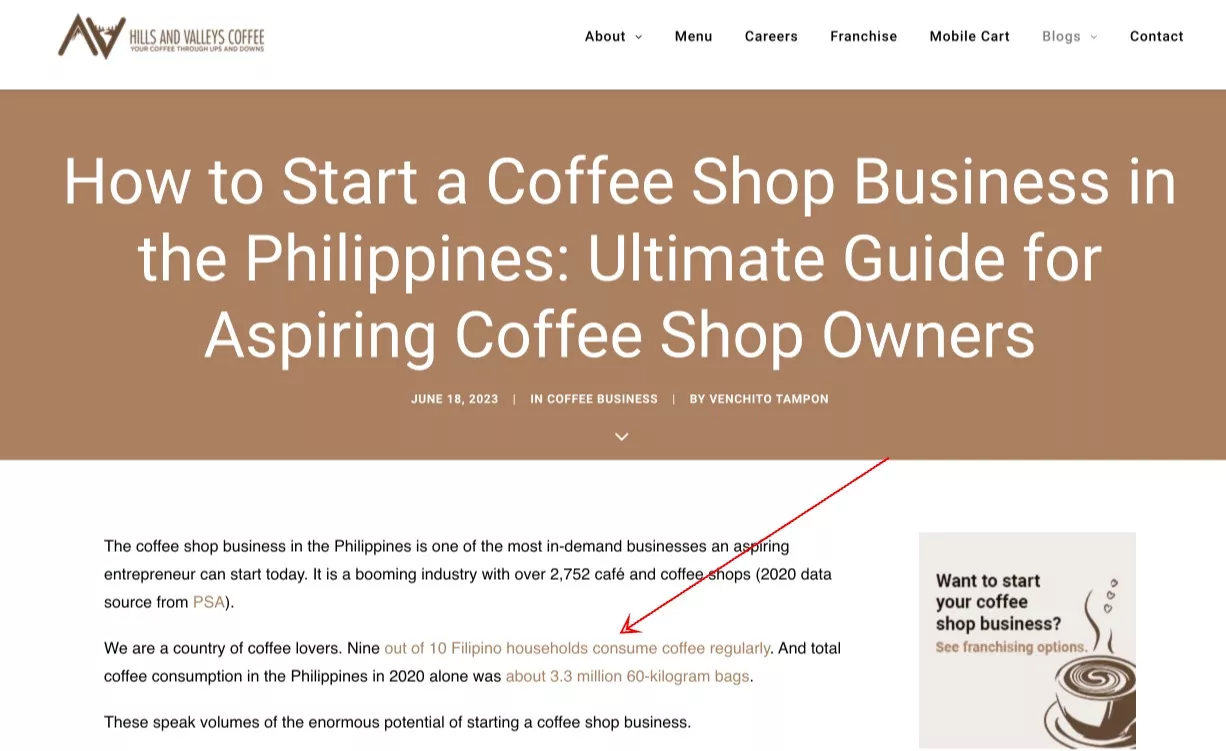
20. PAA Generator
Questions are great sources of ideas for blog posts because they directly tell you your audience’s deepest needs.
Those questions are commonly used phrases to search for references or resources in search engines.
And with the introduction of a knowledge graph, the more direct, useful, and authoritative your answer to a specific question, the higher the possibility of earning the top spot of search results for the exact phrase or question.
How to look for frequently asked questions (FAQs)?
Step 1: Go to PAA Generator.
Step 2: Type in your Country and your head term.
Step 3: Collect all People Also Asked Questions lists with ChatGPT-generated answers. Fact-check and put it at the end of your article as a FAQs section.
21. Email newsletter
Email subscribers are the most engaging audience you want to connect to for content ideation. Because they are already familiar with your brand, you can easily ask for feedback and get their responses quickly via email.
If you already have existing subscribers, you can email them asking for a topic they’d like to discuss on your blog.
Why does this email work?
- The question is straightforward, Is there anything you want me to write a blog post about?. The email also includes that question in its subject line.
- There is an indirect call to action at the end of the email (All you have to do is reply to this email)
You can do the same technique for your brand and make it easy for your team to create content discussing a topic that your followers are looking forward to reading on your blog.
How to Get Blog Post Ideas FAQs
How do I find content ideas for my blog?
On this page, you can find content ideas for your blog by conducting keyword research, analyzing competitor blogs, utilizing social media trends, and seeking inspiration from industry news. Additionally, consider surveying your audience, engaging with online communities, and repurposing your existing content to spark fresh ideas. With these strategies, you’ll never have blog topics to write about.
What are some good blog post ideas?
Some good blog post ideas include: “218 Creative Blog Post Ideas That Will Delight Your Audience”, “How did you get started in your career?”, “List and embed videos that deal with your niche”, “Compile a list of posts and links on one topic”, “What marketing tips didn’t work for you?”, and “Write out a list of FAQs.” Additionally, you can take an unrelated topic and tie it into your field. These ideas will help you create engaging and informative blog posts for your audience.
How do I get inspiration to write a blog?
To get inspiration for writing a blog, look no further than your own life experiences. Reflect on the challenges you’ve overcome, the lessons you’ve learned, and your unique perspectives. Explore your passions and interests, engage in conversations, read books, and listen to podcasts. By drawing from your personal experiences, you’ll create authentic and compelling blog content.
How do I find content ideas?
You can find new content ideas by conducting keyword research, using tools like Google Keyword Planner or SEMrush. Additionally, you can explore social media platforms, join industry-related forums, and engage with your audience through surveys or polls to gather insights. Remember to analyze competitor content and stay updated on industry trends.
The Author
Venchito Tampon Jr
Venchito Tampon is a Filipino Motivational Speaker, Corporate Trainer, and a Leadership Speaker in the Philippines. He is the CEO and Co-Founder of SharpRocket, a link building agency. With a decade of experience, Venchito has a proven track record of leading hundreds of successful SEO (link builidng) campaigns across competitive industries like finance, B2B, legal, and SaaS. His expert advice as a link building expert has been featured in renowned publications such as Semrush, Ahrefs, Huffington Post and Forbes. He is also an international SEO spoken and has delivered talks in SEO Zraz, Asia Pacific Affiliate Summit in Singapore, and Search Marketing Summit in Sydney, Australia. Check out his other businesses, Hills & Valleys Cafe, Blend N Sips and Saas Pursuit.
How our LINK BUILDING AGENCY builds 250 links/mo consistently using Predictable Link Building Methodology™…
- Using a SIMPLE and PROVEN system
- Using a SCALABLE strategy
- No private blog networks
- No creepy outreach emails


